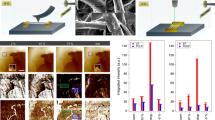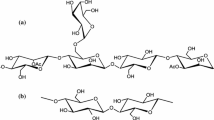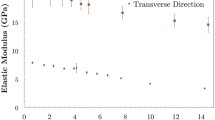Abstract
We present in this study a quantitative estimate of the dispersive interactions between lignin, hemicellulose and cellulose, which are the dominating components in wood and also extensively used to produce paper and packaging materials. The dielectric properties in the UV-visible region of spin-coated films of pure lignin and glucomannan were determined by spectroscopic ellipsometry. The non-retarded Hamaker constants were estimated from the determined spectral parameters using Lifshitz theory for lignin and glucomannan interacting with cellulose, titania and calcium carbonate in vacuum, water and hexane. The Hamaker constants for the different combinations of cellulose, lignin and glucomannan fall within a relatively narrow range of 35–58 and 8–17 zJ, for the values in vacuum (air) and water, respectively. The estimated Hamaker constants for the interactions of the wood components with TiO2 and CaCO3, common additives in paper, in water range from 3 to 19 zJ, thus being similar in magnitude as the interactions between the wood components themselves. In contrast, the Hamaker constant is essentially zero for glucomannan interacting with calcium carbonate in hexane. The Hamaker constants for lignin, hemicellulose and cellulose determined in this study can provide information regarding the surface interactions important for e.g. adhesion, friction, swelling and wetting in paper processing as well as for the resulting behavior of paper products.


Similar content being viewed by others
References
Barsberg S, Matousek P, Towrie M (2005) Structural analysis of lignin by resonance Raman spectroscopy. Macromol Biosci 5:743–752
Beis SH, Mukkamala S, Hill N, Joseph J, Baker C, Jensen B, Stemmler E, Wheeler C, Frederick BG, Heiningen AV, Berg AG, DeSisto WJ (2010) Fast pyrolysis of lignin. BioResources 5:1408–1424
Bergström L (1997) Hamaker constant of inorganic materials. Adv Colloid Interface 70:125–169
Bergström L, Stemme S, Dahlfors T, Arwin H, Ödberg L (1999) Spectroscopic ellipsometry characterization and estimation of the Hamaker constant of cellulose. Cellulose 6:1–13
Carlsson G, Ström G, Annergren G (1995) Water sorption and surface composition of untreated or oxygen plasma-treated chemical pulps. Nord Pulp Pap Res J 10(1):17–23
Dagastine RR, Prieve DC, White LR (2000) The dielectric function for water and its application to van der Waal forces. J Colloid Interface Sci 231:351–358
Denbigh KG (1940) The polarizabilities of bonds—I. Trans Faraday Soc 36:936–948
Ek M, Gellerstedt G, Henriksson G (eds) (2009) Wood chemistry and wood biotechnology. Pulp and paper chemistry and technology. Walter de Gruyter GmbH & Co., Berlin
Feiler AA, Bergström L, Rutland MW (2008) Superlubricity using repulsive van der Waals forces. Langmuir 24:2274–2276
Fox SC, McDonald AG (2010) Chemical and thermal characterization of three industrial lignins and their corresponding lignin esters. BioResources 5(2):990–1009
French RH (2000) Origins and applications of London dispersion forces and Hamaker constants in ceramics. J Am Ceram Soc 83(9):2117–2146
Furman GS, Lonsky WFW (1988) Charge-transfer complexes in kraft lignin. 1. Occurance. J Wood Chem Technol 8:165–189
Gustafsson J, Ciovica L, Peltonen J (2003) The ultrastructure of spruce kraft pulps studied by atomic force microscopy (AFM) and X-ray photoelectron spectroscopy (XPS). Polymer 44(3):661–670
Gustafsson E, Johansson E, Pettersson T, Wågberg L (2012) Direct adhesive measurements between wood biopolymer model surfaces. Biomacromolecules 13(10):3046–3053
Hamaker HC (1937) The London—van der Waals attraction between spherical particles. Physica IV(10):1058–1072
Heathcote MJ (1998) The J&P transformer book a practical tehnology of the power transformer. Newnes, Oxford
Hermans PH, Hermans JJ, Vermaas D (1945) Density of cellulose fibers. II. Density and refractivity of model filaments. J Polym Sci 1:161–165
Hiemenz PC (1986) Principles of colloid and surface chemistry, 2nd edn. Marcel Dekker, New York
Holmberg M, Berg J, Stemme S, Ödberg L, Rasmusson J, Claesson P (1997) Surface force measurement of Langmuir–Blodgett cellulose films. J Colloid Interface Sci 186:369–381
Hough DB, White LR (1980) The calculation of Hamaker constants from Lifshitz theory with applications to wetting phenomena. Adv Colloid Interface 14:3–41
Hu TQ (ed) (2002) Chemical modification, properties, and usage of lignin. Kluwer, New York
Israelachvili J (1991) Intermolecular and surface forces, chap 5, 11.2 edn. Academic Press, San Diego
Laine J, Stenius P, Carlsson G, Ström G (1994) Surface characterization of unbleached kraft pulps by means of ESCA. Cellulose 1(2):145–160
Lee SB, Luner P (1972) The wetting and interfacial properties of lignin. Tappi J 55:116–121
Lifshitz EM (1956) The theory of molecular attractive forces between solids. Sov Phys 2(1):73–83
Milczarek G, Inganäs O (2012) Renewable cathode materials from biopolymer/conjugated polymer interpenetrating networks. Science 335:1468–1471
Ninham BW, Parsegian VA (1970) van der Waals forces: special characteristics in lipid-water systems and a general method of calculations based on Lifshitz theory. Biophys J 10(7):646–663
Norgren M, Edlund H, Wågberg L, Lindström B, Annergren G (2001) Aggregation of kraft lignin derivatives under conditions relevant to the process, part I: phase behaviour. Colloid Surface A 194:85–96
Norgren M, Notley SM, Majtnerova A, Gellerstedt G (2006) Smooth model surfaces from lignin derivatives. I. Preparation and characterization. Langmuir 22(3):1209–1214
Notley SM, Norgren M (2006) Measurement of interaction forces between lignin and cellulose as a function of aqueous electrolyte solution conditions. Langmuir 22:11199–11204
Notley SM, Norgren M (2010) Surface energy and wettability of spin-coated thin films of lignin isolated from wood. Langmuir 26:5484–5490
Notley SM, Pettersson B, Wågberg L (2004) Direct measurement of attractive van der Waals’ forces between regenerated cellulose surfaces in an aqueous environment. J Am Chem Soc 126:13930–13931
Parsegian VA, Ninham BW (1969) Application of the Lifshitz theory to the calculations of van der Waals forces across thin lipid layers. Nature 224:1197–1198
Stoops WN (1934) The dielectric properties of cellulose. J Am Chem Soc 56:1480–1483
Tompkins HG, McGahan WA (1999) Spectroscopic ellipsometry and reflectometry. Wiley, New York
Venkateswaran A (1965) Formulas for the dielectric constant and dissipation factor of mixtures and their application to the cellulose system. J Appl Polym Sci 9:1127–1138
Zhang Y, Li J, Lindström ME, Stephan A, Gatenholm P (2011) Spruce glucomannan: preparation, purification, characterization and derivatization. In: 16th international symposium on wood fiber and pulping chemistry (16 ISWFPC), Tianjin, China
Acknowledgments
This study is part of a project about cellulose based electrical insulation funded by ABB AB and the Swedish Energy Agency through the ELEKTRA program. L.B. and B.F. acknowledge support from the Wallenberg Wood Science Center (WWSC) and the Strategic Research Foundation (SSF). Knut and Alice Wallenberg foundation is acknowledged for support to instrumentation. Lars Ödberg and Claire Pitois are gratefully acknowledged for their valuable input.
Author information
Authors and Affiliations
Corresponding authors
Rights and permissions
About this article
Cite this article
Hollertz, R., Arwin, H., Faure, B. et al. Dielectric properties of lignin and glucomannan as determined by spectroscopic ellipsometry and Lifshitz estimates of non-retarded Hamaker constants. Cellulose 20, 1639–1648 (2013). https://doi.org/10.1007/s10570-013-9980-9
Received:
Accepted:
Published:
Issue Date:
DOI: https://doi.org/10.1007/s10570-013-9980-9




